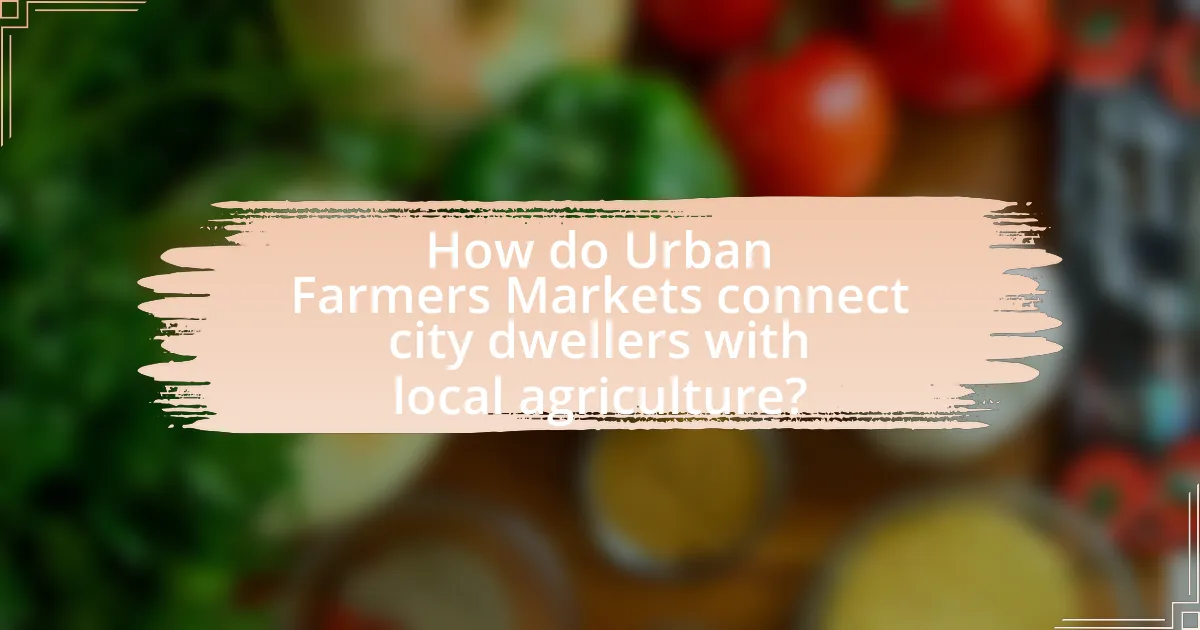Urban farmers markets are designated spaces in urban areas where local farmers sell fresh produce and agricultural products directly to consumers, fostering connections between city dwellers and local agriculture. These markets emphasize local, sustainable produce, often featuring seasonal and organic products, and play a crucial role in supporting local economies by providing direct sales avenues for small-scale producers. The article explores the growing popularity of urban farmers markets, driven by consumer demand for fresh, locally sourced food, and discusses their impact on community engagement, education about food sourcing, and the challenges they face, including regulatory hurdles and competition from larger grocery stores. Additionally, it highlights best practices for both consumers and vendors to enhance their experiences and maximize the benefits of these markets.

What are Urban Farmers Markets?
Urban farmers markets are designated spaces in urban areas where local farmers sell fresh produce and other agricultural products directly to consumers. These markets facilitate the connection between city dwellers and local agriculture, promoting access to fresh, seasonal foods while supporting local economies. According to the USDA, there were over 8,600 farmers markets operating in the United States as of 2021, reflecting a significant increase in consumer interest in locally sourced food.
How do Urban Farmers Markets differ from traditional markets?
Urban farmers markets differ from traditional markets primarily in their focus on local, sustainable produce and direct farmer-to-consumer sales. Urban farmers markets typically feature goods sourced from local farms, promoting seasonal and organic products, while traditional markets may include a wider variety of goods, often from larger distributors or wholesalers. This local emphasis not only supports regional economies but also reduces transportation emissions, as evidenced by studies showing that food miles are significantly lower in local markets compared to conventional grocery stores. Additionally, urban farmers markets often foster community engagement through events and educational programs, enhancing the connection between consumers and producers.
What types of products are typically sold at Urban Farmers Markets?
Urban Farmers Markets typically sell fresh produce, including fruits and vegetables, as well as locally sourced meats, dairy products, baked goods, and artisanal foods. These markets often feature products from local farmers and artisans, promoting community engagement and sustainable agriculture. For instance, a study by the USDA indicates that farmers markets contribute to local economies by providing a direct sales avenue for small-scale producers, enhancing access to fresh food in urban areas.
Who are the primary vendors at Urban Farmers Markets?
The primary vendors at Urban Farmers Markets are local farmers, artisans, and food producers. Local farmers provide fresh produce, including fruits and vegetables, while artisans offer handmade goods such as baked items, crafts, and specialty foods. Food producers may include local dairies, meat suppliers, and beverage makers, contributing to a diverse range of products available at these markets. This vendor composition supports the local economy and promotes sustainable agricultural practices, as evidenced by the increasing number of urban markets that prioritize local sourcing and community engagement.
Why are Urban Farmers Markets becoming popular?
Urban farmers markets are becoming popular due to the increasing consumer demand for fresh, locally sourced food. This trend is driven by a growing awareness of the benefits of supporting local agriculture, which includes improved food quality, reduced environmental impact, and enhanced community engagement. According to a 2021 report by the USDA, farmers markets have seen a 76% increase in the number of markets since 2008, reflecting a significant shift in consumer preferences towards sustainable food systems. Additionally, urban farmers markets provide a platform for local farmers to connect directly with consumers, fostering a sense of community and promoting healthier eating habits.
What social trends are contributing to the rise of Urban Farmers Markets?
The rise of Urban Farmers Markets is primarily driven by increasing consumer demand for locally sourced, organic produce. This trend is fueled by a growing awareness of health and environmental issues, as consumers seek to reduce their carbon footprint and support sustainable agricultural practices. According to a 2021 report by the USDA, sales at farmers markets have increased by over 50% since 2012, indicating a significant shift in consumer preferences towards fresh, local food options. Additionally, urbanization has led to a desire for community engagement and social interaction, with farmers markets serving as vibrant spaces for social connection and cultural exchange.
How do Urban Farmers Markets support local economies?
Urban farmers markets support local economies by providing a platform for local farmers and artisans to sell their products directly to consumers. This direct-to-consumer model increases the income of local producers, as they retain a larger share of the sale price compared to traditional retail channels. According to a study by the USDA, farmers markets can generate up to three times more revenue for farmers than selling through wholesale distributors. Additionally, urban farmers markets stimulate local job creation, as they often require staff for operations and management, further enhancing economic activity within the community. By fostering a connection between consumers and local agriculture, these markets encourage residents to spend their money within the community, thereby reinforcing local economic resilience.

How do Urban Farmers Markets connect city dwellers with local agriculture?
Urban farmers markets connect city dwellers with local agriculture by providing a direct platform for consumers to purchase fresh produce and goods from local farmers. These markets facilitate relationships between urban residents and agricultural producers, fostering a sense of community and supporting local economies. Research indicates that urban farmers markets can increase access to fresh food in urban areas, with studies showing that they often offer higher-quality produce compared to conventional grocery stores. Additionally, they promote sustainable practices by encouraging local sourcing, which reduces transportation emissions and supports regional agricultural systems.
What role do Urban Farmers Markets play in promoting local food systems?
Urban Farmers Markets play a crucial role in promoting local food systems by providing a direct platform for local farmers to sell their produce to consumers. This direct-to-consumer model reduces the distance food travels, thereby minimizing carbon footprints and supporting local economies. According to a study by the USDA, farmers’ markets contribute to the economic viability of local farms, with over 8,000 markets operating in the United States as of 2020, showcasing a significant increase in consumer demand for locally sourced food. Additionally, these markets foster community engagement and education about sustainable agricultural practices, further enhancing the local food system’s resilience and accessibility.
How do these markets educate consumers about food sourcing?
Urban farmers markets educate consumers about food sourcing by providing direct access to local producers and transparent information about agricultural practices. These markets often feature signage and vendor interactions that explain the origins of the food, including details about farming methods, seasonal availability, and the benefits of local sourcing. For instance, studies show that consumers who shop at farmers markets are more likely to understand the importance of sustainable practices and the impact of food miles on environmental health. This direct engagement fosters a deeper connection between consumers and their food sources, enhancing awareness of where their food comes from and how it is produced.
What impact do Urban Farmers Markets have on community engagement?
Urban Farmers Markets significantly enhance community engagement by fostering social interactions and promoting local economic activity. These markets serve as gathering spaces where residents can connect with local farmers, artisans, and each other, thereby strengthening community ties. Research indicates that participation in farmers markets increases social cohesion, as evidenced by a study published in the Journal of Agriculture, Food Systems, and Community Development, which found that 80% of market-goers reported feeling a stronger sense of community. Additionally, urban farmers markets contribute to local economies by supporting small businesses and encouraging the purchase of locally sourced products, which in turn stimulates economic growth within the community.
How do Urban Farmers Markets foster relationships between farmers and consumers?
Urban farmers markets foster relationships between farmers and consumers by creating direct, face-to-face interactions that enhance trust and transparency. These markets allow consumers to engage with farmers, ask questions about farming practices, and learn about the origins of their food, which builds a sense of community and connection. Research indicates that 70% of consumers feel more confident in the quality of food purchased directly from farmers at markets compared to grocery stores, highlighting the importance of personal relationships in food sourcing. Additionally, urban farmers markets often feature local produce, which supports regional economies and encourages consumers to invest in their local agricultural community.
What are the benefits of direct sales for farmers?
Direct sales provide farmers with increased profit margins by eliminating intermediaries, allowing them to retain a larger share of the retail price. This model enables farmers to establish direct relationships with consumers, fostering loyalty and trust. Additionally, direct sales can lead to reduced transportation costs and spoilage, as products are sold closer to their source. According to a study by the USDA, farmers who engage in direct sales can earn up to 50% more than those who sell through traditional channels. This financial benefit, combined with the ability to respond quickly to consumer preferences, enhances the overall sustainability and viability of farming operations.
How do consumers benefit from purchasing directly from farmers?
Consumers benefit from purchasing directly from farmers by gaining access to fresher, higher-quality produce. When consumers buy directly from farmers, they often receive fruits and vegetables that are harvested at peak ripeness, which enhances flavor and nutritional value. Research indicates that produce sold at farmers’ markets can be significantly fresher than that found in grocery stores, as it typically travels shorter distances and is sold soon after harvest. Additionally, direct purchases support local economies, as farmers retain a larger share of the sale price, which can lead to more sustainable agricultural practices. This connection fosters transparency in food sourcing, allowing consumers to know where their food comes from and how it is grown.

What challenges do Urban Farmers Markets face?
Urban farmers markets face several challenges, including regulatory hurdles, competition from larger grocery stores, and issues related to supply chain logistics. Regulatory hurdles often involve complex zoning laws and health regulations that can restrict market operations. Competition from larger grocery stores can undermine the pricing and visibility of local produce, making it difficult for urban farmers to attract customers. Additionally, supply chain logistics can pose challenges in terms of sourcing fresh produce and managing inventory effectively, which can lead to food waste and financial losses. These challenges collectively impact the sustainability and growth of urban farmers markets.
What logistical issues impact the operation of Urban Farmers Markets?
Logistical issues that impact the operation of Urban Farmers Markets include transportation challenges, vendor coordination, and regulatory compliance. Transportation challenges arise from the need to efficiently move perishable goods from farms to urban locations, often requiring timely delivery systems to maintain product quality. Vendor coordination involves managing multiple sellers, ensuring they have adequate space, and scheduling their participation, which can complicate market organization. Regulatory compliance includes adhering to local health and safety regulations, which can vary significantly by city and may require permits or inspections, adding complexity to market operations. These factors collectively influence the effectiveness and sustainability of Urban Farmers Markets.
How do regulations affect Urban Farmers Markets?
Regulations significantly impact Urban Farmers Markets by establishing guidelines for food safety, vendor licensing, and operational hours. These regulations ensure that products sold are safe for consumption, which builds consumer trust and encourages participation. For instance, the Food Safety Modernization Act mandates that farmers adhere to specific safety standards, affecting how they grow and sell produce. Additionally, local zoning laws can dictate where markets can operate, influencing their accessibility to urban dwellers. Compliance with these regulations can also impose financial burdens on small-scale farmers, potentially limiting their ability to participate in markets. Thus, while regulations aim to protect public health and ensure fair practices, they can also create barriers for urban farmers.
What are common challenges related to vendor participation?
Common challenges related to vendor participation in urban farmers markets include regulatory compliance, logistical issues, and competition. Vendors often face difficulties navigating local health and safety regulations, which can vary significantly by location and may require permits or inspections. Logistically, vendors must manage transportation, storage, and setup of their products, which can be particularly challenging for those with limited resources. Additionally, competition from other vendors and larger grocery chains can impact sales and market viability, making it essential for vendors to differentiate their offerings and establish a loyal customer base. These challenges can hinder vendor participation and affect the overall success of urban farmers markets.
How can Urban Farmers Markets overcome these challenges?
Urban farmers markets can overcome challenges by implementing strategic partnerships, enhancing marketing efforts, and improving logistical operations. Strategic partnerships with local organizations, such as community groups and schools, can increase visibility and attract more customers. Enhanced marketing efforts, including social media campaigns and community events, can raise awareness about the benefits of local produce and the market’s offerings. Additionally, improving logistical operations, such as optimizing vendor schedules and ensuring a diverse range of products, can enhance customer experience and satisfaction. These approaches are supported by studies indicating that community engagement and effective marketing significantly boost attendance and sales at farmers markets.
What strategies can be implemented to improve market accessibility?
To improve market accessibility, urban farmers markets can implement strategies such as enhancing transportation options, providing digital platforms for pre-ordering, and offering diverse payment methods. Enhancing transportation options, like shuttle services or bike parking, increases foot traffic and makes markets more reachable for city dwellers. Digital platforms for pre-ordering allow customers to reserve products online, reducing wait times and ensuring availability. Additionally, accepting various payment methods, including mobile payments and food assistance programs, caters to a broader audience, making it easier for diverse populations to participate. These strategies have been shown to increase customer engagement and sales, as evidenced by studies indicating that markets with improved accessibility see higher attendance and revenue.
How can community support enhance the sustainability of Urban Farmers Markets?
Community support enhances the sustainability of Urban Farmers Markets by increasing customer loyalty and participation, which directly boosts sales and vendor viability. When local residents actively engage with farmers markets, they create a consistent customer base that encourages vendors to maintain their operations. Research indicates that markets with strong community backing see a 30% increase in sales compared to those with less engagement, as reported by the Farmers Market Coalition. Additionally, community support fosters a sense of ownership and pride, leading to volunteer efforts that can improve market infrastructure and marketing, further solidifying the market’s presence and sustainability in the urban landscape.
What are best practices for engaging with Urban Farmers Markets?
Best practices for engaging with Urban Farmers Markets include actively participating in community events, promoting local produce, and fostering relationships with vendors. Engaging in community events, such as cooking demonstrations or workshops, helps attract more visitors and educates them about the benefits of local agriculture. Promoting local produce through social media and newsletters increases awareness and encourages residents to support local farmers. Building strong relationships with vendors ensures a diverse selection of products and enhances the market experience, as studies show that markets with engaged vendors see higher customer satisfaction and repeat visits.
How can consumers maximize their experience at Urban Farmers Markets?
Consumers can maximize their experience at Urban Farmers Markets by planning their visit, engaging with vendors, and exploring diverse offerings. Planning involves checking the market schedule and arriving early for the best selection. Engaging with vendors allows consumers to gain insights about the products, including their origin and preparation methods, fostering a deeper connection to local agriculture. Exploring diverse offerings, such as seasonal produce, artisanal goods, and prepared foods, enhances the overall experience and supports local businesses. Research indicates that consumers who interact with vendors report higher satisfaction levels, as they feel more informed and connected to their food sources.
What tips can vendors follow to succeed in Urban Farmers Markets?
Vendors can succeed in Urban Farmers Markets by focusing on product quality, engaging with customers, and effective marketing strategies. High-quality, fresh produce attracts more customers, as studies show that consumers prioritize freshness and local sourcing. Engaging with customers through friendly interactions and storytelling about the products fosters loyalty and repeat business. Additionally, utilizing social media and local advertising can increase visibility and draw in a larger audience, as research indicates that effective marketing can boost sales by up to 30% in local markets.